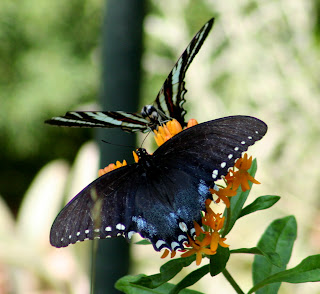
Photo: June 26, 2008
Yesterday, my husband found a Regal Moth (Citheronia regalis) at the bottom of the driveway. He thought it was dying so he brought it up to the house. I was amazed at the size and beauty of this moth and wanted to learn more (which I did from Wikipedia).
I learned that the caterpillars prefer to eat the leaves of hickory and black walnut trees. The bottom of our driveway is also the bottom of Rye Valley so it has the moist soil that walnut trees prefer. So, I am not surprised that the Regal Moth likes it here since there are many black walnut and hickory trees.

Photo: June 26, 2008
I let the moth climb onto the insect screen where she would be safe from my cat. I think she is a female since she doesn't have any antennae which the male has. Later during the day, the moth started pumping her wings, perhaps to release pheromones that the male detects through "its large, plumose antennae."
That evening, I reluctantly decided I shouldn't keep her since I didn't think she was dying. I put her on a hickory tree close to our house. The next morning, she was gone. I am hoping she will lay eggs during her brief life (only one week). The eggs will hatch in about a week to 10 days, with the small caterpillars feasting at night on our many hickories. As the caterpillars age and become larger, they will feed during the day. The large caterpillar's common name is the "Hickory Horned Devil"--referring to the huge red horns on their heads but the caterpillar is harmless and can be handled. The caterpillar will pupate and then reside in the soil over winter, hopefully to emerge next summer if the weather is just right, somewhat hot and humid as it has been lately.
The Regal Moth has become rare further north which may be related to the use of pesticides to control the Gypsy Moth. I found this disturbing. I see the helicopters spraying pesticide on the mountains, including Mountain Lake. It doesn't seem to be doing much good--the Gypsy Moths march on. I am still hoping they won't reach our land because we are surrounded somewhat by farm pastures and the female Gypsy Moth doesn't fly so their spread is mostly tree by tree. If they do come, I don't think I want to have pesticides sprayed on our land. Perhaps the Gypsy Moths will only eat the oaks and not the hickories and walnuts so they can be left for the beautiful Regal Moth. At least, by not spraying, the Regal and other native moths that have caterpillars at the same time as the gypsies would have a chance.
Note: Information for this post came from the Regal Moth page on Wikipedia .

View from the porch of Mountain Lake Hotel June 28, 2008
After my presentation, I learned that the British reality show "Dirty Dancing" was taping the semi-finals competition that afternoon. Some last minute audience cancellations allowed me to go! I was glad I did. The "Johnny and Baby" dancers were great. Also, it was very interesting to see how they produce a television show. The show filmed here last year and was a top hit in Great Britain so they returned this summer. Too bad we don't get British TV but the rumor is that MTV will produce the series here for a US audience so that's exciting. I know this has nothing to do with nature but I wanted to share my exciting day!
Note: see my post Dirty Dancing Hotel and Nature for more information about Mountain Lake Hotel where Dirty Dancing was filmed.











